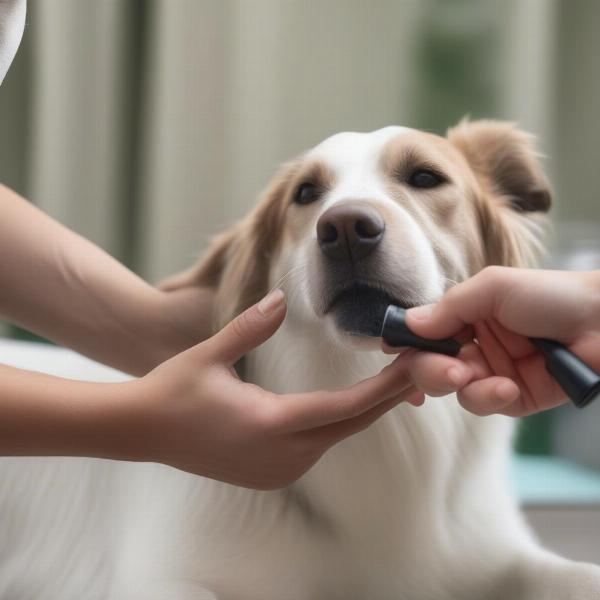Dog no lick sprays are a popular solution for pet owners looking to deter their furry friends from excessive licking, which can lead to irritation, infection, or even self-mutilation. Understanding why your dog is licking excessively is the first step to choosing the right no lick spray and addressing the underlying issue. This guide explores everything you need to know about dog no lick sprays, from their different types and uses to safety considerations and training tips.
Understanding Why Dogs Lick Excessively
Before reaching for a dog no lick spray, it’s crucial to determine the root cause of the licking. Is it a wound, allergy, anxiety, or simply boredom? Some common reasons include:
- Allergies: Environmental or food allergies can cause intense itching, leading to excessive licking.
- Injuries: Licking can be a natural response to soothe and clean a wound, but excessive licking can hinder healing.
- Anxiety or Boredom: Dogs may lick themselves as a coping mechanism for stress, anxiety, or boredom.
- Dry Skin: Dry skin can be itchy and uncomfortable, prompting dogs to lick the affected areas.
- Parasites: Fleas, ticks, and mites can irritate the skin and trigger excessive licking.
- Pain: Licking can be a sign of underlying pain or discomfort.
Types of Dog No Lick Sprays
Dog no lick sprays generally fall into two categories: taste deterrents and soothing sprays.
- Taste Deterrents: These sprays contain bitter or unpleasant-tasting ingredients that discourage licking. They are often effective for deterring licking of wounds, bandages, or furniture.
- Soothing Sprays: These sprays are formulated with ingredients that help soothe irritated skin and reduce itching. They are often a good choice for dogs with allergies or dry skin.
Choosing the Right Dog No Lick Spray
When selecting a no lick spray, consider the following factors:
- Underlying Cause: Address the root cause of the licking. If it’s an allergy, consider an anti-itch spray. For wounds, a taste deterrent might be more appropriate.
- Ingredients: Opt for natural and non-toxic ingredients, especially if your dog has sensitive skin. Avoid sprays with harsh chemicals or alcohol.
- Veterinarian Recommendation: Consult your veterinarian for recommendations tailored to your dog’s specific needs.
 Applying Dog No Lick Spray
Applying Dog No Lick Spray
Using Dog No Lick Spray Safely
Always follow the manufacturer’s instructions carefully. Test the spray on a small area of skin first to check for any adverse reactions. Avoid spraying near the eyes, nose, and mouth.
Combining No Lick Spray with Training
While no lick sprays can be effective, they should be used in conjunction with training and behavior modification to address the underlying cause of the licking.
- Positive Reinforcement: Reward your dog for not licking.
- Distraction: Provide alternative activities to keep your dog occupied and reduce boredom.
- Address Anxiety: Create a calm and predictable environment for your dog.
When to Consult a Veterinarian
If excessive licking persists despite using a no lick spray and implementing training techniques, consult your veterinarian. The licking could be a sign of a more serious underlying medical condition.
Conclusion
Dog no lick sprays can be a helpful tool in managing excessive licking, but they are not a standalone solution. Identifying and addressing the underlying cause of the licking is crucial for long-term success. By combining no lick spray with appropriate training and veterinary care, you can help your furry friend break free from the lick cycle and enjoy a healthier, happier life. Remember to always choose a safe and effective spray and consult your veterinarian if you have any concerns.
FAQ
- Are dog no lick sprays safe? Most dog no lick sprays are safe when used as directed. Always choose a spray with natural ingredients and avoid contact with the eyes, nose, and mouth.
- How do I choose the right no lick spray? Consider the underlying cause of the licking and choose a spray accordingly. Consult your veterinarian for recommendations.
- Can I make my own dog no lick spray? While DIY recipes exist, it’s generally recommended to use commercially available sprays that have been tested for safety and effectiveness.
- How long does it take for a no lick spray to work? Results vary depending on the product and the individual dog. Some sprays may work immediately, while others may take a few days to show noticeable effects.
- What if my dog still licks after using the spray? Consult your veterinarian. The licking may be a sign of a more serious underlying condition.
- Can I use a no lick spray on a puppy? Always consult your veterinarian before using any product on a puppy.
- Are there any side effects of using a no lick spray? Some dogs may experience mild skin irritation or gastrointestinal upset if they ingest the spray.
ILM Dog is a leading online resource for dog owners worldwide, providing expert advice on all aspects of dog care and wellbeing. From breed selection and health care to training and nutrition, we offer practical and reliable information to help you provide the best possible care for your canine companion. We specialize in providing guidance on Dog Breeds and Selection, Health and Medical Care, Training and Behavior, Nutrition and Feeding, Grooming and Hygiene, and Products and Accessories. Contact us today for personalized support and expert guidance: Email: [email protected], Phone: +44 20-3965-8624. Visit ILM Dog for more information.